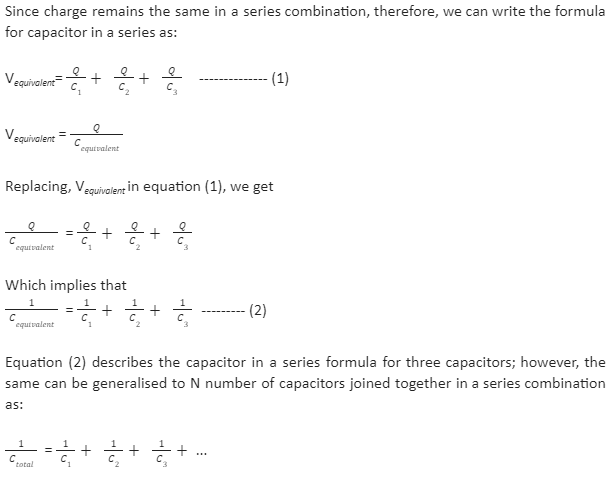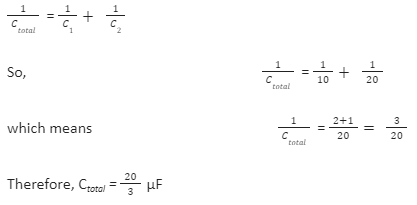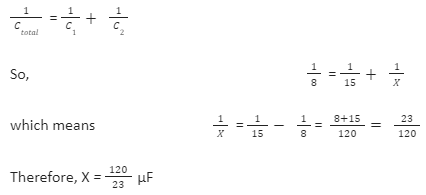A capacitor is a device that has the capacity to store energy. Capacitors have two parallel plates of metal filled with a dielectric inside, which gets polarised when connected to a voltage bias. Due to this polarisation, the molecules align themselves opposite to the charge of the metal plate. The electrostatic field inside the metal plates is formed when the capacitor is in a charging mode and continues to charge till no more molecules are left to polarise. Once a capacitor is fully charged, it attains a steady-state condition.
A capacitor in series formula describes a mathematical description when two or more capacitors are joined together in a series combination.
Capacitors in Series
When two or more capacitors are joined, the charge remains constant, or the current remains the same; the combinations obtained are the capacitors in series. In a series combination, capacitors are joined adjacent to one another such that the plate on the right hand is connected to the plate on the left hand. The voltage drop for a capacitor in a series combination is different. The equivalent capacitance for a capacitor in a series formula depicts that the total capacitance is less than the individual capacitances and, therefore, can be calculated by the concept of resistance in a parallel combination. The resulting capacitance decreases when the plate area increases, provided we keep all the other factors constant.
Capacitor in Series Formula
Let the circuit combination contain three capacitors joined together in a series combination having capacitances of C1, C2, and C3 respectively. The capacitor in a series formula can be derived as follows:

The point of importance in capacitors in series formula is that the effective or equivalent capacitance is always less than the capacitance of individual capacitors. Such a feature of capacitors in series can hold a wide range of real-life applications.
Examples of Capacitors in Series
The capacitors in series formula importance is realised while solving numerical problems as shown below:
Example 1: Two capacitors having capacitances of 10 μF and 20 μF are connected in series. Find out the total capacitance of the given combination.
Solution: Given, C1= 10 μF and C2= 20 μF
According to the capacitor in a series formula,

Example 2: Two capacitors having capacitances of 15 μF and X μF are connected in series. The total equivalent capacitance of the given combination is 8 μF. Find X.
Solution: Given, C1= 15 μF and C2= X μF and Ctotal = 8 μF
According to the capacitor in a series formula,

Application of Capacitors in Real Life
Since we live in an era of advanced technology, producing miniaturised smart devices requires capacitors. A few real-life examples of capacitors are as follows:
- A capacitor is an energy-storing device; so, when a computer system shuts down, the capacitor circuit installed can provide emergency power till the system gets power. This happens because the capacitor gets charged when the device is connected to the power source and stores energy.
- Batteries used in mobile phones or cameras do not provide sufficient energy for a long time. So, the cameras are fitted with capacitor circuits to get enough power to switch on flash mode.
- A rectifier device uses a capacitor filter to convert AC to DC signal. A rectifier is used in electronic appliances.
Conclusion
Capacitors are energy storage circuit elements with an insulating material inside their plates. The capacitance measures a dielectric’s energy storage capacity and is measured in Farad. Learning about capacitors is very important to understand electronics since capacitors are widely applicable in everyday life.
 Profile
Profile Settings
Settings Refer your friends
Refer your friends Sign out
Sign out






